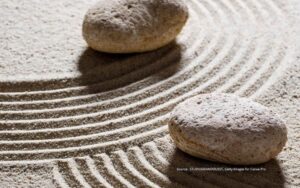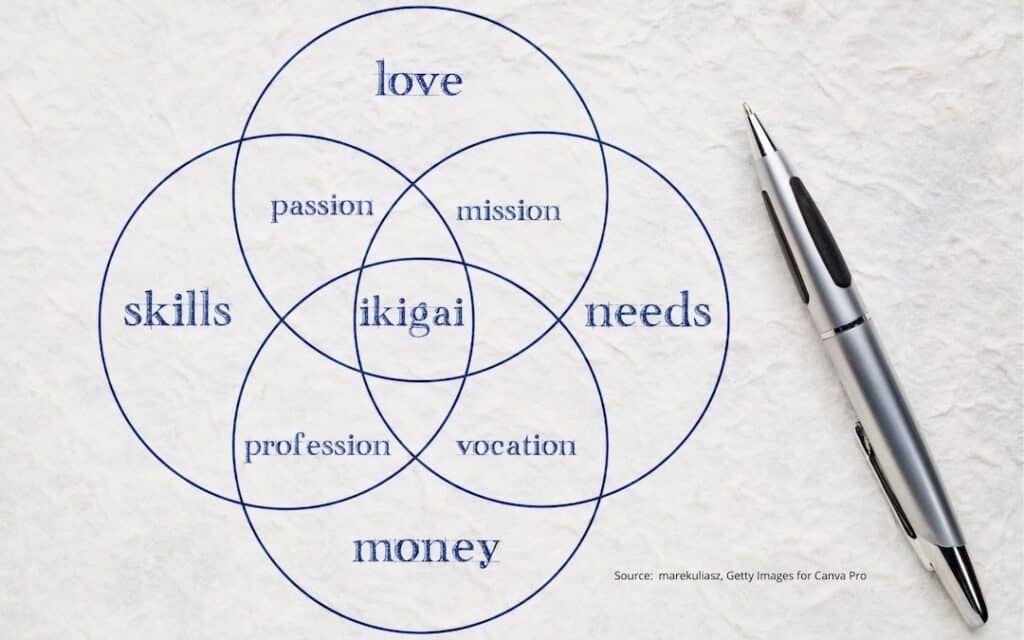An intricate Venn diagram appeared in my LinkedIn feed a few years ago. The four circles showed different traits that contribute to an intersectional definition of ikigai, including what you might be good at, what you can get paid for, etc. The diagram implied that if you could hit the bullseye of this complicated structure, you would attain ikigai.
Can you imagine how stressful it would be to hit such a narrowly focused target? We don’t “win” ikigai. Indeed, we need to move away from overthinking and over-engineering this concept and, instead, take a more holistic approach to living a life that allows for less achievement and more fulfillment. So, below, I explain ikigai, explore some of its myths, and introduce a different interpretation.
What is Ikigai?
Ikigai (pronounced ee-kee-guy) is a Japanese concept that has become popular in Western culture. But that leads me to the first myth, which begins with how Westerners define it through their lens. Westerners typically describe ikigai as a reason for being (co-opted from raison d’être). That then morphed into an active search for an externally validating sense of purpose.
In reality, ikigai is more of a comprehensive concept encompassing the value in living. That includes both doing and being. In other words, when defining our worth, we must look within to examine our actions and existence. We cannot allow someone else to do that for us.
I can see why people prefer the Venn diagram. It presents the illusion of logic, suggesting that you cross out the sections where you feel you achieved ikigai and conduct a gap analysis to identify what you are missing. But it’s far more nuanced than that.
Finding value in living is about seeing small, subtle wonders in everyday life. For those of us who were conditioned to be achievement-oriented, that can be an extremely frustrating exercise. Therefore, I will share some tips below on incorporating small ikigai activities into your life.
Some Other Myths about Ikigai

Beyond the Western-centric definition of ikigai, there are other myths worth covering. For example, do any of the following statements sound familiar?
Finding ikigai is about finding happiness.
Many writings suggest that the path to ikigai includes finding your passion and purpose in life and that only then will it lead to happiness. Can you imagine how stressful that process is for people who haven’t been able to “find” their purpose? It simply isn’t true.
The concept of Ikigai is about acknowledging that a well-balanced life is not always about happiness. It’s about recognizing the small yet subtle good things in our lives to create contentment.
Ikigai includes what people will pay you to do.
Money is the quintessential extrinsic motivator, and receiving payment for doing something is the exact opposite of finding motivation from within. If your job is one way you find value in life, that’s fantastic. But that value doesn’t come from the money, title, or an upward career path. It comes from something deeper within you that triggers a sense of fulfillment.
For example, sometimes people tell me their jobs are rewarding because they love their coworkers, enjoy interacting with the people they serve, or feel they are contributing something valuable to the world. None of those reasons have anything to do with payment.
Ikigai is about what the world wants from you.
Not always, but this one is tricky. There is a lot of storytelling surrounding the people who stepped up to do something brave and heroic to fulfill their purpose. But, in many ways, ikigai is the opposite of that. It’s about being a part of a world where we define fulfillment for ourselves, knowing that no matter what, our contributions matter, even when they are not recognized.
How to Find Your Ikigai

Sometimes, my clients express frustration because they say they haven’t “found” their ikigai. They worry they are missing out on something important by not identifying their purpose or “north star.” Or, they think that for ikigai to be worthwhile, others must recognize it as something important and life-changing, and once they figure that out, everything else will fall into place.
Here’s the truth: very rarely do we “find” ikigai. Instead, it emerges when you notice the bright spots that arise in your relationships and daily activities. The trick is to pay attention to it and to realize that it may not be life-changing but life-affirming. Ikigai helps us see what is happening in the moment and allows us to create a sense of connection and purpose through action. It’s not about finding joy or happiness. It’s about understanding what gives us a sense of meaning and contentment in our lives.
When I work with clients who wish to explore this concept, I typically start small by asking them to consider the following questions:
- Who is important to me?
- What daily routines do I value right now? What makes them essential, and how do I feel when performing them?
- What is one thing in my life that I want to pay more attention to over the next few days?
I ask them to sit with those questions for a moment. Then, I give them a worksheet with more questions to explore until our next meeting. Click the link below to download the free ikigai worksheet to do this exercise yourself.
How Will You Know When You Have Found Your Ikigai?
For all the reasons I mentioned earlier, ikigai is not something you achieve, so you may not necessarily “find” it. However, your reaction might surprise you when your life becomes more aligned with your ikigai. My clients often report a quiet sense of confidence and a feeling of ease that comes from being in alignment. They also say they notice what is missing: stress, tension, and confusion.
In other words, finding and living a life worth living is about discovering what is meaningful and essential to you and then allowing that knowledge to guide your decisions and behaviors. When you can do that with confidence, you will feel more grounded.
The Bottom Line
Contrary to popular belief in our Western culture, the Japanese concept of ikigai is not something to achieve, nor can you sum it up in a fancy ikigai diagram. It is about paying closer attention to the things that bring you joy and exploring how to take intentional actions that allow you to find value in your everyday life. For more strategies on blending the practice of ikigai into your life, try answering the questions in the ikigai worksheet above or visit our resource page for more exercises.





